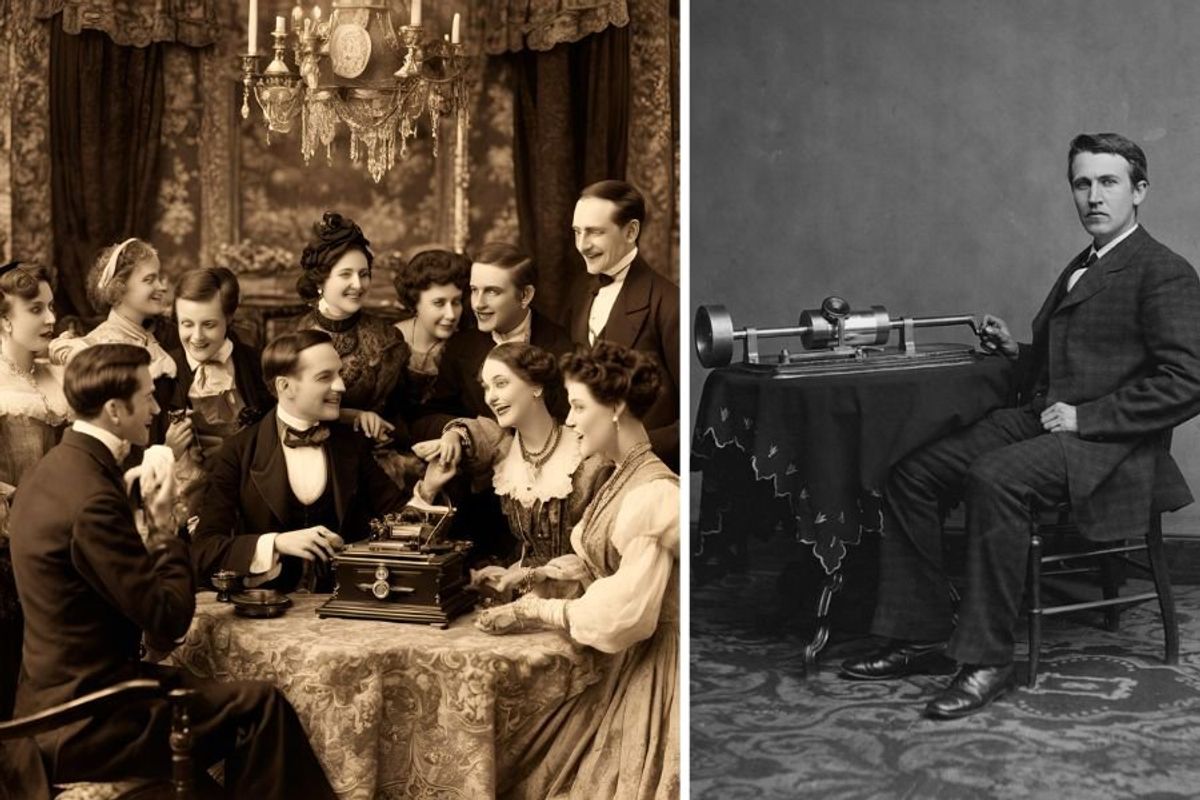Listen to famous Victorians having a ball recording their voices for the very first time
Getting drunk and speaking into a phonograph used to be prime entertainment.

It's so cool to listen to them ponder a future that would become our present.
The latter part of the Victorian era brought us the invention of photography, and along with it a more realistic—though not completely accurate—glimpse into what life of the time period looked like. And yet, the same can’t be said for what 19th century folks sounded like.
While technically the first recording of a human voice did happen in 1860 (very early on in the Victorian era), it wouldn’t be until the 1880s, when Thomas Edison perfected the technology with his new-and-improved wax cylinder phonograph, that voice recording would become more of a commonplace concept.
In a video created by Kings and Things, we are thrust back in time to when this device made its debut, and subsequently captured the voice of many Victorian era icons. During an evening soirée held in London, George Gouraud, an American employee of Edison, decided to delight his guests by inviting them to record their own personalized message to Edison.
This novel form of entertainment would always start the same way—Gouraud would first toast the guest before prompting them to speak. Needless to say, things would quite quickly turn into drunken fun.
- YouTubewww.youtube.com
But there was also a bit of unintentional foreshadowing that came about. Composer Sir Arthur Sullivan, for example, all but predicted the kind of impact this technology would have on music.
"For myself I can only say that I am astonished and somewhat terrified at the results of this evening's experiments: astonished at the wonderful power you have developed, and terrified at the thought that so much hideous and bad music may be put on record forever,” he said.
Gouraud would hold many demonstrations of the phonograph, both at his home in London and at other social events with elite guests, hoping to record the “voices of the great of all nations, to include alike someday the voices of the living and the dead” so that they might be available for future generations.
Getting that kind of extensive archive, however, wasn’t always easy. Even today, many of us get choked up at the thought of talking on the telephone. The nerves were understandably similar, if not worse, for Victorians not only interacting with a daunting device for the first time, but also the concept of their voice being immortalized.
“It is curious to see how the most distinguished speakers behave when they find themselves in front of the photograph and speak into it,” Gouraud noted. Even the famously confident stage actor Sir Henry Irving apparently became "frightened out of his own voice.”
Eventually other “recordists” were brought on to replicate Gouraud’s work of demonstrating the phonograph. And one of them recorded one of the most well known and influential Victorians of them all, the founder of modern nursing herself—Florence Nightingale.
Here’s what the Lady with the Lamp had to say:
“When I am no longer even a memory, just a name, I hope my voice may perpetuate the great work of my life.”
Other notable recordings include politician William Gladstone and Queen Victoria herself—though her recording was replayed to the point of damaging the quality, and it’s hard to accurately detect whose voice it might belong to. It would be much, much later that any of the recordings could be replayed without any degradation.
This entire video is a great reminder that while we might not ever be able to truly time travel (although here’s hoping!) , that doesn't mean we won’t continue finding new ways to experience the past. It’s also interesting to think what folks a hundred years from now will think of the many, many questionable recordings of ourselves that will live on forever via the internet.
Check out more of Kings and Things' content here.
- Unearthed BBC interview features two Victorian-era women discussing being teens in the 1800s ›
- In 1889, a British newspaper asked women why they were 'spinsters' and the responses were incredible ›
- What Hollywood gets wrong about corsets, and how the Victorians actually got a tiny waist ›
- Victorian business woman reveals what it was like in 1800s - Upworthy ›





 Traditional strawberry farming takes up a lot of land.
Traditional strawberry farming takes up a lot of land. season 7 episode 6 GIF
season 7 episode 6 GIF diane guerrero latina GIF by Identity
diane guerrero latina GIF by Identity Dexters Laboratory Type GIF
Dexters Laboratory Type GIF Courtesy of Kerry Hyde
Courtesy of Kerry Hyde Courtesy of Kerry Hyde
Courtesy of Kerry Hyde Courtesy of Kerry Hyde
Courtesy of Kerry Hyde Courtesy of Kerry Hyde
Courtesy of Kerry Hyde Girl Illustration GIF by Valérie Boivin
Girl Illustration GIF by Valérie Boivin Jennifer Lopez Applause GIF by NBC World Of Dance
Jennifer Lopez Applause GIF by NBC World Of Dance